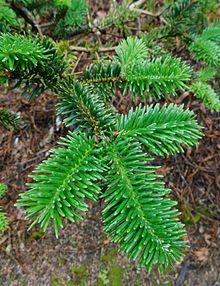Abies forrestii
| Abies forrestii | ||||||||||||
|---|---|---|---|---|---|---|---|---|---|---|---|---|

Abies forrestii var. Georgei |
||||||||||||
| Systematics | ||||||||||||
|
||||||||||||
| Scientific name | ||||||||||||
| Abies forrestii | ||||||||||||
| Coltm.-Rog. |
Abies forrestii is a species of fir ( Abies ) in the pine family(Pinaceae). The homeland of this species of conifer is in China . It is named after George Forrest (1873–1932).
description
Abies forrestii grows as an evergreen tree that can reach heights of up to 20 meters. The bark is dark gray and usually flakes off. The bark of the twigs is initially hairy and has a reddish brown to brown color, with increasing age it darkens until it is dark gray after two to three years. The resinous winter buds are spherical to obovate.
The needles , arranged in two rows on the branches in a comb shape, are 1.5 to 4, but mostly 2 to 3 centimeters long and 2 to 2.5 millimeters wide. On the underside of the needle there are two white stomatal bands and there are two resin channels on the edges.
The flowering time is in May. The sessile, sessile cones are cylindrical to obtuse-cylindrical with a length of 7 to 12 centimeters and a diameter of 3.5 to 6 centimeters. The ripe cones are dark purple-brown to black-brown in color. The cover scales sitting in the middle of the cone are fan-shaped, trapezoidal, 1.3 to 2 centimeters long and 1.3 to 2.3 centimeters wide. The winged seeds are about 1 inch long. The wing of the seed is light brown to reddish brown and broadly wedge-shaped. The seeds ripen from October to November.
Distribution and location
Abies forrestii is native to western China . They occur in southwest Sichuan , eastern Xizang and northwest Yunnan .
It occurs in mountain regions at altitudes from 2500 to 4200 meters. The climate of their home locations is damp and cold with an annual rainfall of 1000 to 2000 millimeters, the soils are gray-brown podsol soils. Abies forrestii is often the only tree species to be found here at the tree line, but is also associated with the Likiang spruce ( Picea likiangensis ), Larix potaninii , the Himalayan hemlock ( Tsuga dumosa ) and at lower altitudes with deciduous tree species such as Betula albosinensis , maples ( Acer ) and whitebeams ( Sorbus ).
Hazard and protection
In the Red List of the IUCN is Abies forrestii "not at risk" out. It is pointed out, however, that a new review of the hazard is necessary.
Systematics
Abies forrestii is assigned to the Pseudopicea section and the Delavayianae subsection within the genus of firs ( Abies ) . The recognized today name was in March 1919 by Charles Coltman-Rogers in the Gardeners' Chronicle first published . In the same year, but a few months later, a description appeared under the same botanical name by William Grant Craib .
Abies forrestii was formerly partially considered a variety of Delavay's fir ( Abies delavayi ), which it resembles. A synonym is, inter alia, Abies delavayi var. Forrestii (Coltm.-Rog.) ABJacks.
Varieties
Abies forrestii is occasionally divided into four varieties:
- Abies forrestii var. Ferreana (Bordères & Gaussen) Farjon & Silba . Synonyms include Abies chayuensis W.C.Cheng & LKFu , Abies ferreana Bordères & Gaussen , Abies rolii Bordères & Gaussen and Abies yuana Bordères & Gaussen : It occurs from southeastern Tibet to northwestern Yunnan.
- Abies forrestii var. Forrestii (Syn .: Abies forrestii var. Chengii (Rushforth) Silba , Abies chengii Rushforth ): It occurs from southeastern Tibet to southwestern Sichuan and northwestern Yunnan.
- Abies forrestii var. Georgei (Orr) Farjon (Syn .: Abies georgei Orr ): It occurs from southeastern Tibet to southwestern Sichuan and northwestern Yunnan.
- Abies forrestii var. Smithii Viguié & Gaussen : It occurs in the northwestern Yunnan.
use
The wood is used as construction timber . Tannin is extracted from the bark .
swell
- Christopher J. Earle: Abies forrestii. In: The Gymnosperm Database. www.conifers.org, accessed January 14, 2011 .
- Liguo Fu, Nan Li, Thomas S. Elias, Robert R. Mill: Abies. In: Wu Zheng-yi, Peter H. Raven (Ed.): Flora of China . Volume 4: Cycadaceae through Fagaceae . Science Press / Missouri Botanical Garden Press, Beijing / St. Louis 1999, ISBN 0-915279-70-3 , pp. 11 (English). , online .
- Gordon Cheers (Ed.): Botanica. The ABC of plants. 10,000 species in text and images . Könemann, Cologne 2003, ISBN 3-8331-1600-5 .
Individual evidence
- ↑ a b c d e f Liguo Fu, Nan Li, Thomas S. Elias, Robert R. Mill: Abies. In: Wu Zheng-yi, Peter H. Raven (Ed.): Flora of China . Volume 4: Cycadaceae through Fagaceae . Science Press / Missouri Botanical Garden Press, Beijing / St. Louis 1999, ISBN 0-915279-70-3 , pp. 11 (English). , online .
- ↑ Christopher J. Earle: Abies forrestii. In: The Gymnosperm Database. www.conifers.org, accessed January 14, 2011 .
- ↑ Abies forrestii in the endangered Red List species the IUCN 2010. Posted by: Conifer Specialist Group, 1998. Retrieved on January 17, 2011th
- ↑ Abies forrestii. In: Germplasm Resources Information Network. www.ars-grin.gov, accessed on January 14, 2011 (English).
- ↑ a b c d e f Rafaël Govaerts (Ed.): Abies. In: World Checklist of Selected Plant Families (WCSP) - The Board of Trustees of the Royal Botanic Gardens, Kew . Retrieved April 5, 2019.
- ↑ Abies forrestii. In: The Plant List. www.theplantlist.org, accessed on January 14, 2011 .
Web links
- Abies forrestii in the endangered Red List species the IUCN 2010. Posted by: Conifer Specialist Group, 1998. Retrieved on January 17, 2011th
